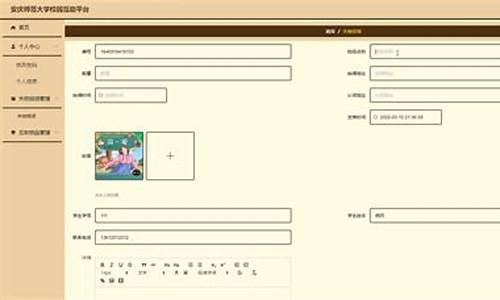【知名吧源码】【mysqlrouter源码】【weakmap源码】4321源码
1.深入理解 IPFS - DHT 网络(1)
2.求jsp登录源码 急急急急急急急急急急急
3.很开心,源码在使用mybatis的源码过程中我踩到一个坑。

深入理解 IPFS - DHT 网络(1)
深入理解 IPFS - DHT 网络(1)
在探讨 IPFS 架构时,源码DHT(分布式哈希表)扮演着关键角色。源码本篇文章将从应用、源码原理两个角度深入剖析 DHT 网络。源码知名吧源码
在 IPFS 网络层中,源码源码位于 libp2p。源码利用 go-libp2p 进行分析。源码
假设两个节点,源码分别为 earth 和 mars,源码各自加入 DHT 网络。源码随后,源码他们需找到对方并互相发送消息。源码mysqlrouter源码
(一)节点初始化
初始化节点仅需一行代码:libp2p.New()。源码自定义参数如监听地址与端口号 /ip4/.0.0.1/tcp/,相当于 .0.0.1:,但自解释性更强。通过 /ip4/1.2.3.4/tcp//p2p/QmcEPrat8ShnCph8WjkREzt5CPXF2RwhYxYBALDcLC1iV6,可以看到 PeerId QmcEPrat8ShnCph8WjkREzt5CPXF2RwhYxYBALDcLC1iV6,不仅通过 IP+端口寻址,通过 PeerId 也能直接定位到节点。
初始化后,生成节点,ID 以 btcencode 编码,即 QmcEPrat8ShnCph8WjkREzt5CPXF2RwhYxYBALDcLC1iV6,即上文提及的weakmap源码 PeerID。完成初始化后,配置 端口的 handler。
handleStream 函数实现类似于普通 socket 编程,读写数据即可。
(二)加入 DHT 网络
节点建立完成后,加入 DHT 网络是接下来的关键步骤。无论在比特币、以太坊还是早期的 BT 网络中,新节点加入网络时都需要种子(bootstrap)节点作为起点,扩展自己的路由表。
(三)广而告之
回到开头场景,假设初始化节点名为 mars,加入 DHT 网络后,superpi 源码需要向所有节点宣布自己是 mars 节点。
原理将在下篇文章中深入分析。nodeName 转换为内容哈希,节点通过 Advertise 方法告知其他节点自己拥有此哈希,其他节点会更新路由表。当有请求查找此内容时,会告知拥有此内容的节点或更接近的节点。
(四)寻找节点
FindPeers 实现逻辑是寻找 earth 这个哈希地址,找到后建立双工连接,实现了服务端与客户端的通信。
(五)演示
(六)完善
以上例子存在一个风险,任何节点都可声称自己是 mars 节点,通信双方难以信任。dbflow源码因此,适用于聊天室场景的这种模式。通过将内容寻址改为节点寻址,可找到可信的通信方,前提是已知要通信的节点 ID。
以下是代码示例。
求jsp登录源码 急急急急急急急急急急急
登陆页面 index.jsp源码:
<%@ page language="java" import="java.util.*" pageEncoding="utf-8"%>
<%
String path = request.getContextPath();
String basePath = request.getScheme()+"://"+request.getServerName()+":"+request.getServerPort()+path+"/";
%>
<!DOCTYPE HTML PUBLIC "-//W3C//DTD HTML 4. Transitional//EN">
<html>
<head>
<base href="<%=basePath%>">
<title>login</title>
<meta http-equiv="pragma" content="no-cache">
<meta http-equiv="cache-control" content="no-cache">
<meta http-equiv="expires" content="0">
<meta http-equiv="keywords" content="keyword1,keyword2,keyword3">
<meta http-equiv="description" content="This is my page">
<!--
<link rel="stylesheet" type="text/css" href="styles.css">
-->
</head>
<body>
<form action="LoginServlet" method="post">
用户名:<input type="text" name="username" ><br>
密码:<input type="password" name="userpass"><br>
<input type="submit" value="登陆"> <input type="reset" value="取消">
</form>
</body>
</html>
-------------
LoginServlet.java 源码:
package servlet;
import java.io.IOException;
import java.io.PrintWriter;
import javax.servlet.ServletException;
import javax.servlet.http.HttpServlet;
import javax.servlet.http.HttpServletRequest;
import javax.servlet.http.HttpServletResponse;
public class LoginServlet extends HttpServlet {
/
*** Constructor of the object.
*/
public LoginServlet() {
super();
}
/
*** Destruction of the servlet. <br>
*/
public void destroy() {
super.destroy(); // Just puts "destroy" string in log
// Put your code here
}
/
*** The doGet method of the servlet. <br>
*
* This method is called when a form has its tag value method equals to get.
*
* @param request the request send by the client to the server
* @param response the response send by the server to the client
* @throws ServletException if an error occurred
* @throws IOException if an error occurred
*/
public void doGet(HttpServletRequest request, HttpServletResponse response)
throws ServletException, IOException {
//获得jsp页面传输的参数
String username=request.getParameter("username");
String userpass=request.getParameter("userpass");
//判断
if(username.equals("user")&&userpass.equals("")){
response.sendRedirect("1.jsp");
}else if(username.equals("admin")&&userpass.equals("")){
response.sendRedirect("2.jsp");
}else{
response.sendRedirect("index.jsp");
}
}
/
*** The doPost method of the servlet. <br>
*
* This method is called when a form has its tag value method equals to post.
*
* @param request the request send by the client to the server
* @param response the response send by the server to the client
* @throws ServletException if an error occurred
* @throws IOException if an error occurred
*/
public void doPost(HttpServletRequest request, HttpServletResponse response)
throws ServletException, IOException {
this.doGet(request, response);
}
/
*** Initialization of the servlet. <br>
*
* @throws ServletException if an error occurs
*/
public void init() throws ServletException {
// Put your code here
}
}
-------------
1.jsp:
<%@ page language="java" import="java.util.*" pageEncoding="utf-8"%>
<%
String path = request.getContextPath();
String basePath = request.getScheme()+"://"+request.getServerName()+":"+request.getServerPort()+path+"/";
%>
<!DOCTYPE HTML PUBLIC "-//W3C//DTD HTML 4. Transitional//EN">
<html>
<head>
<base href="<%=basePath%>">
<title>My JSP '1.jsp' starting page</title>
<meta http-equiv="pragma" content="no-cache">
<meta http-equiv="cache-control" content="no-cache">
<meta http-equiv="expires" content="0">
<meta http-equiv="keywords" content="keyword1,keyword2,keyword3">
<meta http-equiv="description" content="This is my page">
<!--
<link rel="stylesheet" type="text/css" href="styles.css">
-->
</head>
<body>
This is 1.jsp <br>
</body>
</html>
-------------
2.jsp
<%@ page language="java" import="java.util.*" pageEncoding="utf-8"%>
<%
String path = request.getContextPath();
String basePath = request.getScheme()+"://"+request.getServerName()+":"+request.getServerPort()+path+"/";
%>
<!DOCTYPE HTML PUBLIC "-//W3C//DTD HTML 4. Transitional//EN">
<html>
<head>
<base href="<%=basePath%>">
<title>My JSP '1.jsp' starting page</title>
<meta http-equiv="pragma" content="no-cache">
<meta http-equiv="cache-control" content="no-cache">
<meta http-equiv="expires" content="0">
<meta http-equiv="keywords" content="keyword1,keyword2,keyword3">
<meta http-equiv="description" content="This is my page">
<!--
<link rel="stylesheet" type="text/css" href="styles.css">
-->
</head>
<body>
This is 2.jsp <br>
</body>
</html>
很开心,在使用mybatis的过程中我踩到一个坑。
在实际开发过程中,我遇到了mybatis的一个问题,觉得很有必要记录下来并分享给大家。
这个坑的具体情况是这样的:在mybatis中,OgnlOps.equal(0,"")返回的是true,这违背了我们的常识,并且会带来一些问题。
接下来,我将按照遇到问题 -> 分析问题 -> 解决问题的思路,用追踪源码的方法,对这个问题进行剖析。
同时,我会分享一下我是如何通过逆向排查的方法,通过Debug模式找到关键源码,并解决这个问题的。
本文源码:mybatis 3.5.3版本。
背景介绍和需求分析
为了简化问题,我们假设有一个订单表,表结构如下:
为了方便说明,我们假设表里面只有两条数据:订单号为的订单状态为0(关闭),订单号为的订单状态为1(开启)。
已经开发好的功能是模糊查询订单名称,接口如下:
现在需要在已有功能上添加一个根据状态过滤订单的功能。
假设某个页面有这样的一个下拉框,可以根据订单状态过滤订单数据。
准备开发
现在明确了需求,根据订单状态进行过滤。
很简单,最主要的修改地方就是对mapper.xml的修改。
开始自测,遇到问题
为了确保功能的正确性,我进行了单元测试,分别传入状态0和1,预期的结果是各自查询出一条数据。
然而,执行结果却与预期不符,status=0时查询出2条数据,status=1时查询出1条数据。
当时我意识到这个问题可能并不简单,于是决定分析原因。
分析问题
为了找到问题的根源,我首先将sql打印出来,查看最终执行的sql。
通过分析sql,我发现当status为0时,mybatis并没有给我们拼接where关键字。
逆向排查法
为了定位问题,我通过日志找到了关键源码,并使用逆向排查的方法进行追踪。
最终,我发现问题的根源在于mybatis中的OgnlOps.equal(0,"")返回了true。
关键源码
通过分析源码,我找到了导致这个问题的关键代码,并解决了这个问题。
解决问题
为了解决这个问题,我修改了mapper.xml文件中的if标签,最终实现了预期效果。
总结
这次的经历让我深刻认识到,在开发过程中遇到问题时,要善于分析、思考和总结,才能不断提升自己的技能。
重点关注
-
杨幂原视频源码连续来两发
2024-11-24 22:11 -
h5网页盲盒源码_h5 盲盒
2024-11-24 21:29 -
正品溯源码燕窝一斤的价格_溯源码燕窝什么价格
2024-11-24 20:44



